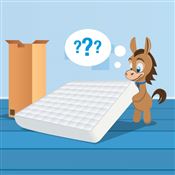Why Are There So Many Mattress Stores
New stores shut down every day, but not mattress stores. There are even more mattress stores than Starbucks—but why?
 |
| © CreditDonkey |
How Many Mattress Firm Stores Are There?
There are almost 16,000 mattress stores in the United States, according to IbisWorld. These 16,000 stores generate a total revenue of $14 billion.
Mattress Firm, one of the most popular mattress chains in the U.S., has over 2,600 locations across the country. This also includes their other stores like Sleepy's and Sleep Train.
That's a lot of real estate for just mattresses. Many of these stores make enough to money to pay rent and then turn a profit. Keep reading to find out how they stay afloat.
Reasons for Multiple Mattress Stores
 |
| © CreditDonkey |
Hint: It's not a money-laundering conspiracy. Everybody wants quality sleep. Mattress stores are popular because they fill that need. Find out the top reasons you see them on every corner.
As of 2019, there were approximately 16,000 mattress stores in the U.S. The same year, there were a reported 15,000 Starbucks stores.
Mattress Stores Have Low Overhead
The average mattress costs between $900 and $2,000. Mattress prices are commonly marked up by 50% or more. That gives mattress sellers big profits on just one sale. In fact, mattress stores need to sell fewer than 20 mattresses per month to cover operational costs.
Mattress stores don't have a lot of overhead, either. Many don't carry a large inventory in store. Instead, they keep mattresses at a nearby warehouse and ship them to the customer.
Some stores even ship directly from the manufacturer. This lets them sell mattresses without ever having to manage their products.
Mattress stores don't typically have a lot of staff working at one time. Most employees work on commission. So if they don't make a sale, they don't get paid.
Because mattress stores have such low overhead, keeping them open isn't too costly. Many mattress stores will stay open for long hours or in a less profitable market just to act as an advertisement for the mattress chain.
Mattresses are commonly marked up by 40% to 50%. But, some can be marked up by more than 100%. That makes for a huge profit margin. In comparison, non-mattress retailers usually have profit margins of 1.5% to 3% per product.
Consumers Like to Try Out a Mattress
Online mattress companies like Saatva and Nectar don't pose a huge threat to the mattress industry—for now.
According to researchers at Second Measure, the combined first-quarter sales from the top six online sellers only equaled 62% of Mattress Firm's sales.
Many people just aren't comfortable buying mattresses completely online yet. Although a bed in a box can be convenient, many buyers want to test their options in person.
Buying a new mattress is a big deal. You'll likely use it for at least 8 to 10 years before getting another. Plus, you spend about 33% of your life sleeping. Because of this, many people don't want to buy a mattress blind.
Even with generous trial periods, it can be hard to know exactly what you'll get when shopping online. Most models are exclusive to each brand, too, so it's tough to compare across stores. That's why some online retailers have even opened up brick-and-mortar stores.
People love to comparison shop. When stores are close together, they drive traffic to each other. You're more likely to check prices at Mattress Store X after shopping at Mattress Store Z.
The practice of opening similar retailers in close proximity is called "agglomeration," and it's not unique to mattress stores. It's why you often see fast food restaurants clustered together or right across the street.
The Economic Downturn Created High Demand
If there's one thing people put off when money is tight, it's buying a new mattress. Who can afford to spend $1,000 or more on a new bed when they're living paycheck to paycheck?
As a result of the 2008 recession, people cut back on unnecessary purchases, including mattresses. After the economy bounced back, people were ready to get that long overdue mattress.
Mattress stores expanded aggressively to meet the demand. But was this a big mistake?
Try shopping for a mattress during late winter or early spring. This is when sellers discount last year's models to make room for new models. Otherwise, try shopping around major holiday weekends like Presidents Day, Labor Day, and Memorial Day.
Too Many Mattress Stores?
Around the time that the money-laundering conspiracy theory took off, there were 3,500 Mattress Firm stores in the U.S.
If it seemed like there were a ridiculous number of stores open, that's because there were. Mattress Firm filed for bankruptcy in 2018 and closed more than 700 stores as a result.
So, there's no conspiracy theory after all. The truth is a bit more boring. The mattress industry makes it easy to keep stores open. Pair this with a company that expands too quickly and you get a mattress store on every corner.
Mattress manufacturers recommend replacing your mattress every 7–10 years. A mattress' life depends on its type, quality, and use. At the 10-year mark, it has usually worn down enough to look for a replacement.
Why There are So Many Online Mattress Brands
There are about 175 online bed-in-a-box companies in business. Why so many?
The reasons are similar to why there are so many physical stores. Online companies have little overhead costs and high profit margins. The technology that rolls the mattresses up into smaller boxes also makes them cheaper to ship.
Many mattress companies don't manufacture their beds themselves. The process is outsourced, which brings costs down. So, it doesn't take too much to start an online mattress company. (Whether a company can be successful is another story.)
What Experts Say
CreditDonkey assembled a panel of industry experts to answer readers' most pressing questions:
- How have consumer buying habits changed between generations?
- What are some causes for a business growing too fast too soon?
Here's what they said:
Can You Negotiate the Price of a Mattress?
Because of the huge markup, you should definitely negotiate the price of a mattress.
Some experts even recommend haggling the price down as much as 50%. Discounts that high aren't common, but many salespeople will be willing to give you at least a small discount to make a sale.
When you negotiate, don't just focus on the retail price of the mattress. Try haggling the cost of delivery. You might also get them to waive the price of hauling away your old mattress.
Because there are so many mattress stores, it's easy to shop around. Check local advertisements each week to make sure you're getting a competitive deal.
When salespeople see you hopping across the street to their competitor, they'll feel pressure to complete the sale. You can use that to your advantage. Or, you can try shopping online. You'll find consistently lower prices without having to haggle.
How much is your mattress worth?
Want to know the value of your mattress before negotiating the price? This easy-to-use calculator provides an instant estimate based on the mattress' original price and age.
Here's how to use the calculator:
- Enter the price at which you bought the mattress.
- Input how long you've had your mattress.
- Click "Calculate."
From there, you should see the cost per year and night of the mattress.
Bottom Line
While mattress conspiracy theories are fun to entertain, the truth boils down to efficient economics. Everyone needs a mattress and they are one of the least expensive retail stores to run.
Take advantage of the numerous stores in your area by comparison shopping to get the best deal.
Write to Kim P at feedback@creditdonkey.com. Follow us on Twitter and Facebook for our latest posts.
Note: This website is made possible through financial relationships with some of the products and services mentioned on this site. We may receive compensation if you shop through links in our content. You do not have to use our links, but you help support CreditDonkey if you do.
Not sure what mattress is right for you?
Answer a few short questions in our mattress quiz to receive tailored recommendations.
|
|
| ||||||
|
|
|













